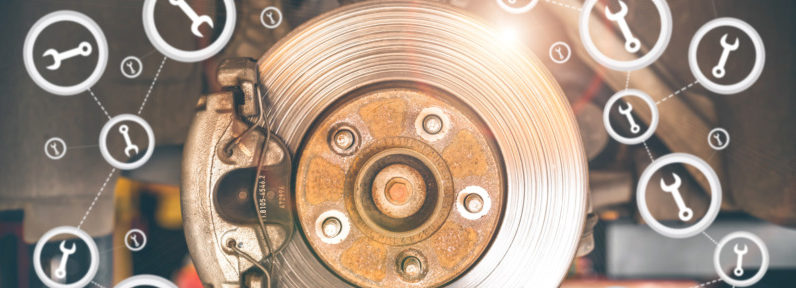Understanding what inventory is most appropriate for your particular market is critically important, and past performance isn’t always a reliable predictor of current demand.
By Martha Uniacke Breen
As the demand for maintenance continues slowly to recover across Canada, brake service is predictably, near the top of the list in terms of consumer demand. Whether a consumer’s vehicle has been driven more kilometres in the past few months, or remains where it’s been for the last year or so – which is to say, mainly sitting in the owner’s driveway – it’s a service that few consumers are willing to postpone.
But it does mean that understanding what inventory is most appropriate for your particular market is critically important, and past performance isn’t always a reliable predictor of current demand. We asked Nathan O’Hara, Business Development Manager, First Brands Group, and Nathan Killeen, ATE Brake Systems Product Manager at Continental, for advice on how jobbers can strike a balance between adequate coverage and appropriate inventory mix, even in this uncertain market.
First, what are the key application growth areas that jobbers should be watching closely right now, in the fall of 2021?
“The key application growth areas that jobbers should be watching closely right now continue to be crossovers, SUVs and pickup trucks,” says First Brands Group’s Nathan O’Hara. “For example, Ford only has one car left in their lineup, and they just reintroduced the Ranger pickup truck and Bronco SUV models with the all-new Maverick pick up/crossover coming out 2022.”
According to Nathan Killeen of Continental, “Late-model European applications are areas of growth that deserve more focus by jobbers. These applications are typically found in higher-end vehicles with larger, higher performance brake components, where installers and customers are focused on using replacement parts that perform equally as or better than Original Equipment parts.
“The use of high-quality parts virtually eliminates ‘come-backs’ due to noise or poor performance,” Killeen continues. “In the past few years, Continental has seen a significant shift from lower-quality brake pads and rotors to OE components that these high-performance applications demand.”
Often, suppliers can be an excellent resource, with tools and resources to help them create the proper inventory balance for their own specific markets.
“We strongly believe in helping jobbers attain the appropriate inventory mix for the brake category. When the mix is right, inventory turns improve,” observes O’Hara. “The tools and resources that we have available are a combination of current sales history by region, VIO [vehicles in operation] and estimated demand for those VIO.
“Estimated demand is a particularly valuable insight,” he goes on. “While there may be a lot of a specific application in a region, the wear rate of the brake parts varies by application; certain applications, in the same vehicle class, wear brakes faster than others. This is where estimated demand in combination with VIO and local sales history can help sharpen a jobber’s inventory mix.”
Nathan Killeen explains that Continental’s product management works closely with the cataloguing team to ensure the release and availability of key part numbers that are in high demand. “We use various tools to help identify high VIO for specific makes and models. This data can be broken down by geographical location to determine target markets, and is used to identify popular OE numbers and well as key model year ranges. The appropriate part numbers are then released based on this data, and inventory levels are monitored closely to ensure that the demand is sufficiently met. This provides jobbers with the latest and most popular applications that will help result in the highest sales volumes.”
Regenerative Braking
With steadily growing interest in electric vehicles, plug-in electrics and hybrids these days, techs are encountering regenerative braking systems in greater numbers, and this presents a set of unique challenges to the jobber in addressing this burgeoning demand accurately.
Says Continental’s Killeen, “Because the popularity of EVs is dramatically increasing in the automotive marketplace and these vehicles are logging higher mileage, technicians are seeing more coming in for service.” Unlike standard friction brakes, regenerative braking converts kinetic energy into electricity, which greatly reduces the wear and tear of brake pads and rotors.
O’Hara points out that while the regenerative brake systems in most electrics and hybrids will not wear as quickly, they are prone to premature failure because of less frequent demand, creating a growing opportunity for brake service and brake fluid flushes. “Regular brake service is more important than ever to extend the life of the braking system and fight corrosion from beet juice and calcium chloride, which is used extensively in the Eastern part of the country to help melt snow and ice on the roads and highways,” he says.
Killeen goes on to add that although this design significantly reduces pad and rotor wear, maintenance is still a key point in keeping the braking system in good shape and operating at top performance. “An important maintenance consideration is the hydraulic systems. The hydraulic components used in EV brake systems are similar to those used in conventional vehicle brakes. They contain brake fluid, slides in the calipers, pistons, and other moving parts. These components require service and maintenance, especially in harsh conditions to ensure optimal performance. Since brake fluid is hydroscopic, it should also be changed every 2-3 years to avoid corrosion within the brake system that can cause premature wear.”
Whether the demand in your area is growing towards EVs and regenerative braking systems, or still largely confined to standard friction technology, especially in heavy-duty use or where winters are harsh, ask your representative what tools and resources they have to help guide the prop inventory mix for your situation. Especially in the current unpredictable market, this assistance can be highly valuable.


0 Comments